Becky Shindell Better Together: Search and Social #semrushchat 79 Wow-Score The Wow-Score shows how engaging a blog post is. It is calculated based on the correlation between users’ active reading time, their scrolling speed and the article’s length. Learn more Better Together: Search and Social #semrushchat
- 149
- 54
- 30
- 1
SEO and Social Media Marketing can be planned and executed separately, but they are far more effective if used in conjunction with one another to enhance your efforts. That is why, during our latest SEMrush Chat, we discussed how search and social are better together with Jaydip Parikh, digital marketing pro, speaker, SEO, social media, and eCom consultant, CEO of Tej SolPro, and SEOTalk CoFounder. They joined our other chat guests to talk about the relationship between the two areas and tips on how these fields can complement each other:
Q1. What is the main difference between SEO & Social Media Marketing? Is one more useful than the other?
Our chat participants agreed that both search marketing and social media are important. The main difference is that these fields are used equally for different things.
A1. Both are useful, Generally SEO works more good with B2B industries while Social helps more to B2C. #SEMrushchat
— Jaydip Parikh (@JaydipParikh) September 20, 2017
SEO efforts are focused on attracting relevant traffic primarily made behind the scenes, while social media marketing is all about interactions and building relationships between your brand and your audience.
A1: Equally useful for different things. SEO is under-the-hood while social media marketing means more face-to-face interaction #semrushchat
— Jumpshot (@jumpshotinc) September 20, 2017
A1 SEO is anticipating a conversation & planning it; Social Media Marketing is having a conversation & building relationships #SEMRushChat
— Bill Slawski (@bill_slawski) September 20, 2017
Social Media activities are aimed at appealing to people’s emotions. Companies post on social platforms to evoke happiness, sadness, love, and other feelings and with social media, brands are able to target their audience based on who they are, what they like, and where they spend their time, e.g., Facebook, Twitter, LinkedIn, Pinterest, etc.
SEO, on the other hand, is focused on creating content that answers users’ questions and is mainly based on audience research. SEO specialists target users based on what they search for and how they do it, what phrases and language they use.
A1) SEO is more technically focused while social marketing is more about striking the right emotional chords with audience. #semrushchat
— Kyle Murray (@TheKyleMurray) September 20, 2017
A1: To me it comes down to the content. SEO is more research based content and social is more emotional response. #SEMrushchat
— Danny Ray Lima (@dannyraylima) September 20, 2017
A1: SEO is targeting people who are raising their hands and saying "I am looking for…" social does not do this yet. #SEMrushchat
— Steve Seeley (@SteveSeeley) September 20, 2017
SEO is a long-term investment. It takes time to deliver results, but when done right, it can be an ongoing source of quality traffic. On the other hand, results from social media activities can happen within minutes after you publish your post. However, these results are usually short-lived, which is why you need to support your SMM constantly.
A1: With good SEO your content's going to be read for years to come, with SM it'll be gone in a flash #SEMrushChat
— zestylemon (@zestylemon) September 20, 2017
A1: SEO seems more static and long-term-focused. While social about engaging in the moment. #semrushchat #notasocialmediaexpert
— Carolyn Lyden (@Carolyn_Lyden) September 20, 2017
In a nutshell, the main difference between SEO and social media marketing comes down to the following criteria:
-
Purpose. Attracting traffic to your website vs. building relationships.
-
Content. Research-based content vs. an appeal to emotions.
-
Audience targeting. What your users are thinking about vs. who your users are.
-
Durability. Slow and long-term vs. instant and short.
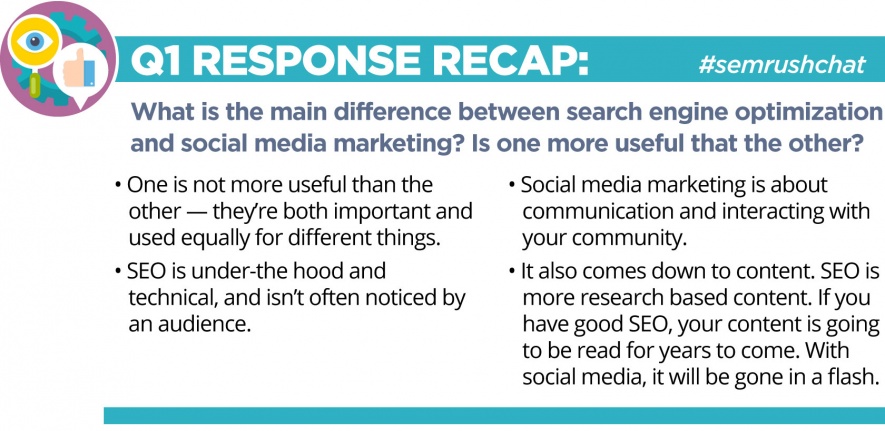
Q2. What are the top social media marketing activities search engines consider in their algorithms?
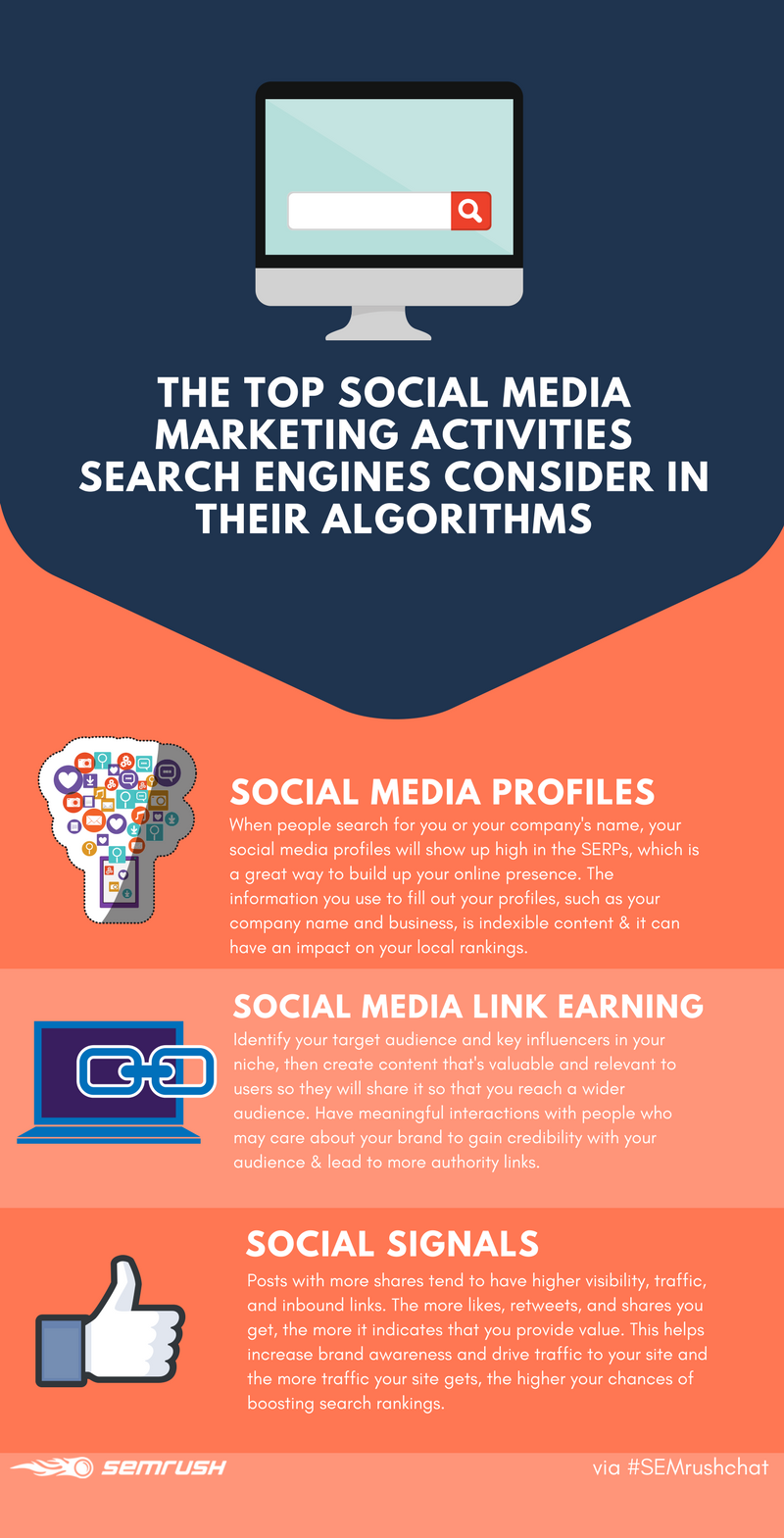
Special thanks to everyone whose tweets we used to make this image: @JaydipParikh, @AccuraCast, @fighto, @DarioZadro.
A smart social media campaign can indirectly improve your rankings. You just need to make sure to fill out your social profiles with useful information, promote your content via social platforms, and engage with your audience and influencers in your niche.
Q3. How does paid social traffic increase search engine rankings?
When it comes to paid social media, many businesses are hesitant to get started with it, because they have gotten used to the idea that social media is a free way to market. However, paid social media traffic can be a powerful way to quickly grow your audience.
Our chat guests pointed out that paid social doesn’t directly increase your search engine rankings. However, it has some secondary effects that do. For example, paid social puts your content in front of people who may have never heard of your brand. The more often users see your brand, the more familiar they get with your business. Even if your social media ads don’t get clicked, every impression they get contributes to increased brand awareness.
A3: Directly? It doesn't. Indirectly, as with any paid media, it influences branding/awareness, influencing organic search.#semrushchat https://t.co/QpMnkF4JVO
— ThinkSEM (@ThinkSEM) September 20, 2017
Paid social can help you to boost your content with advanced targeting to attract more attention to your brand. You have more control over who sees your posts, as compared to organic social media content and social media ads allow you to target a specific audience segment and have a better understanding of who sees your posts. Thanks to this, you can craft your content for a particular audience and promote specifically to them and as a result, this qualified traffic will more likely convert.
A3: Directly? It doesn't. Indirectly, it impacts search volume and SERP Click-through rate (brand recognition) #semrushchat
— Kevin_Indig (@Kevin_Indig) September 20, 2017
A3. It send signal to search engine, this is something hot content and that might trigger the things. It's CTR game. #SEMrushchat https://t.co/KYC3r3BH0V
— Jaydip Parikh (@JaydipParikh) September 20, 2017
Paid social enables brands to expand their reach by targeting hundreds of millions of users on a daily basis.
A3: Directly? It doesn't increase rankings at all. Indirectly, paid social increases brand exposure, which can do wonders! #semrushchat
— Dario Zadro (@DarioZadro) September 20, 2017
Paid social is a great way to amplify your content to the right audience, at the right time, with the right message, increasing your brand awareness and attracting more quality traffic to your website. This, in turn, can have a significant impact on your search rankings. When combined, SEO and social media activities become a single marketing force that can do wonders.
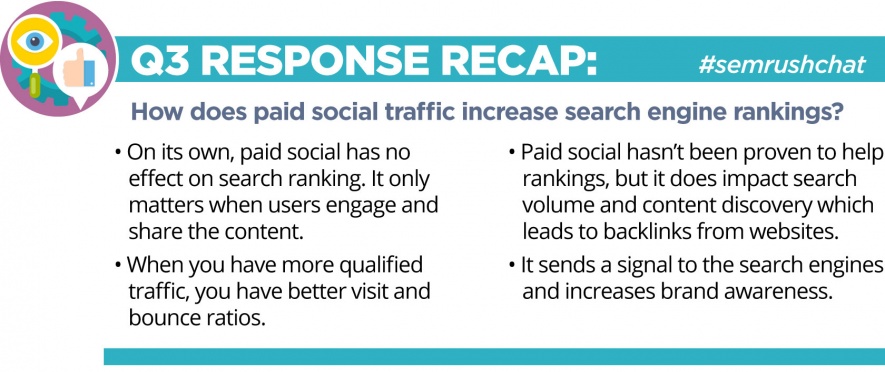
Q4. What are the most effective ways to combine your SEO and social efforts?
-
Find Social Media Influencers and Engage with Them
Engaging with key influencers in your niche can result in significant SEO benefits. It won’t help you to directly boost your SEO efforts, but solid connections with industry influencers will encourage more inbound links. You need to invest time and effort to engage with some big fish in your field who may be interested in your content and build long-term relationships with them.
a4) Use social to identify influencers. Build relationships with them, get links from them and their audiences. #semrushchat
— Ryan Johnson (@rsj8000) September 20, 2017
-
Promote Your Content on Social Media
Even the most epic piece of content needs a solid promotion strategy. You can use social media to promote your content to your audience and acquire high-quality backlinks.
Make sure:
-
You use the right social networks where your target audience spends their time.
-
You produce content that’s relevant and interesting to your specific audience.
When sharing content on social, create a unique post for each social platform you use and use the customizable features on each network. This includes various elements, such as images, headlines, and descriptions of the content you are promoting. The more optimized and customized your post is for a specific platform, the more successful your social media promotion will be.
A4: Leverage SM for content marketing. Btr to add social share buttons on your website. #semrushchat
— Sayan Sarkar (@SayanTheGeek) September 20, 2017
-
Find Out What Your Audience Wants
Social networks are a great place to find out what your user’s interests are and discover fresh content ideas. Conversations on Twitter can indicate specific, targeted topics that people in your industry discuss. When it comes to Facebook, brand pages contain comments in which users ask or demand something. You can take advantage of this information to create valuable content that effectively targets your audience.
A4: social should give you answers as to what people want in real time thus giving you the content to create and target. #SEMrushchat
— Steve Seeley (@SteveSeeley) September 20, 2017
To see the main demographic of your Facebook fans, try out Facebook Audience Insights, which provides you with a good idea of their age and location. Twitter's Audience Insights enables you to take a real-time look at the people who are most relevant to you and it gives you an overview of your followers’ interests, lifestyle, demographics, and purchase behaviors.
A4 Analytic insights from social should be shared with site content teams – SEO optimise on findings #SEMRushChat
— Simon Cox (@simoncox) September 20, 2017
-
Take Advantage of Cross-Channel Remarketing.
Using remarketing, or retargeting, to reach your audience can help you to strengthen your overall digital marketing efforts. It allows you to target people you have already reached out to with your marketing activities, but haven’t converted yet. By using retargeting, you can serve social ads to those who have visited your site or users based on what they are searching for on search engines.
A4, Remarketing each other traffic, Create Social profiles for ORM and Branding, #SEMrushchat https://t.co/wL1xtqeutx
— Jaydip Parikh (@JaydipParikh) September 20, 2017
-
Specify Your Social Profiles to Google.
Schema markup helps website owners generate brand signals, which can enhance their knowledge graph entry and website snippet presence in the SERPs. By using structured data markup on your site, you can add your social profile information to Google Knowledge Graph cards in some searches. You can specify various types of social profiles, including Facebook, Twitter, LinkedIn, Instagram, Pinterest, YouTube, Tumblr, and more.
a4) Use schema to connect social channels to website for maximum knowledge graph recognition. #semrushchat
— Ryan Johnson (@rsj8000) September 20, 2017
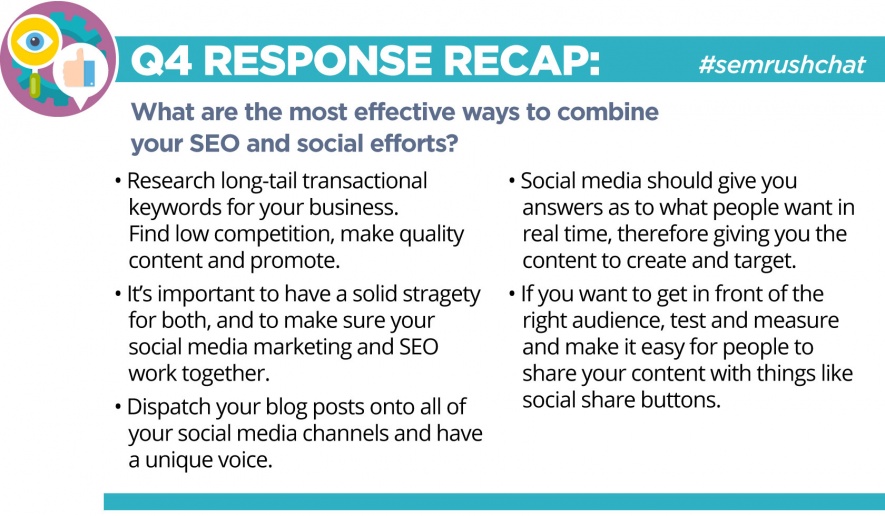
Q5. What are the future trends in the areas of search engine marketing and social media marketing?
1. Voice Search
There have already been many talks on how voice search can alter the SEO landscape. But, how can voice search affect social media marketing? So far, not many users turn to voice search and commands to interact with other people. However, this percentage is expected to rise, as more and more users continue to leverage voice search. According to David Neuman, Director of Social and Sales Strategy for RhythmOne, brands that take advantage of voice search are expected to see more traffic and engagement when pushing it out through their social channels.
A5: Voice. We're moving toward voice search (with Google Home, Amazon Echo, etc.)–so social's got to be next. #semrushchat
— Carolyn Lyden (@Carolyn_Lyden) September 20, 2017
Brands that want to capitalize on voice search need to create a website and social content that directly answers the most common questions asked by their target audience and do it in simple clear sentences.
A5: #1:Voice Search
#2 Voice Search
#3: Voice Search #SEMRushChat— Saad AK (@SaadAlikhan1994) September 20, 2017
2. Focus On the User
By making new changes to its algorithms, Google tries to deliver the most relevant content to its users. This means that the way businesses implement keywords and create content changes as well. To keep up with Google, companies need to keep in mind user’s intent when doing keyword research and create more user-focused content.
A5: They both are going to continue to focus more on the user; that might be voice search becoming more important to users. #semrushchat
— Netvantage Marketing (@netvantage) September 20, 2017
When it comes to social media, marketers are expected to see a more personalized approach. Social media channels represent a sterling opportunity for brands to engage with their audience on a deeper level. By delivering them a personalized message businesses can provide their customers with an outstanding user experience that will create a valuable bond.
A5. Search is becoming more about query's intent than just mere having content.
SMM will continue to be more personalized #semrushchat— Praveen Sharma (@i_praveensharma) September 20, 2017
3. Mobile Optimization
In the digital era, literally, everyone uses their smartphones and tablets to search for information online. Businesses that don’t cater to the needs of their mobile-first audience will lag behind their competitors. You need to make sure that you provide a great user experience to your audience on any device to appeal to the new digitally savvy generation.
A5: #1: Optimization for user intent
#2: More rich answers and snippets
#3: Increased mobile growth #SEMRushChat— Saad AK (@SaadAlikhan1994) September 20, 2017
4. Video Content
Fast-evolving technologies have enabled a widespread video consumption. It is still growing and will continue to expand in the near future and users now have the ability to watch video almost always, at any time on any device. That’s why, you shouldn’t rely on one video platform if you want to reach your audience. To get the most out of your video content, make sure to distribute it on social platforms that your audience uses. In social media, we can see the rise of short video stories and expiring content, such as Facebook Stories.
A5: video is here and now but I think we can do more to harness it for SEO and SMM #semrushchat
— Jamie Paton (@NJayme) September 20, 2017
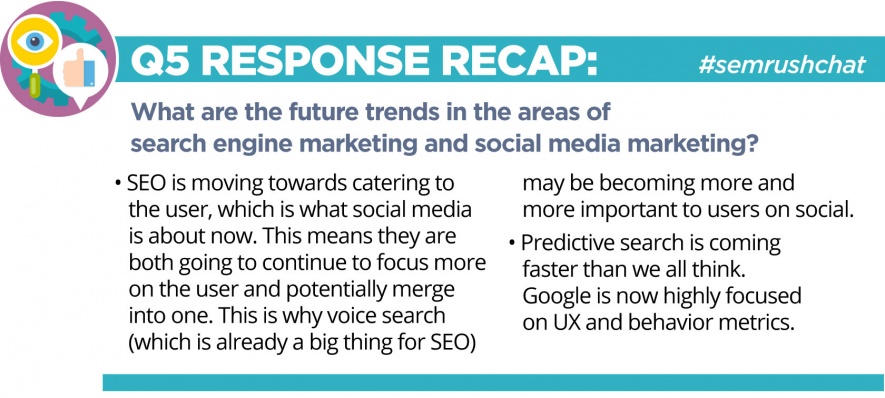
Although search is still the primary way of how users find content, people today don’t limit their searching solely to Google, but also look for information they need all over Facebook, Twitter, and other social platforms. That is why search and social media can and should work together. These areas are more interconnected now than ever before and it’s not likely to change soon.
Many thanks to Jaydip Parikh and our other chat guests for sharing great insights into search and social!
Make sure to join our next chat as we discuss how to stay up to date with Google's algorithm changes!
SEOSocial Media  Becky Shindell Becky Shindell is the US Social Media Manager at SEMrush and host of the weekly #SEMrushchat. Connect with her on LinkedIn and follow her on Twitter. You can find Becky at many of the US Digital Marketing Conferences, feel free to say hi!Read the original article here
Becky Shindell Becky Shindell is the US Social Media Manager at SEMrush and host of the weekly #SEMrushchat. Connect with her on LinkedIn and follow her on Twitter. You can find Becky at many of the US Digital Marketing Conferences, feel free to say hi!Read the original article here



